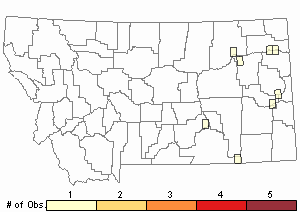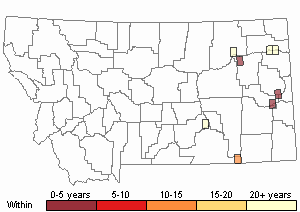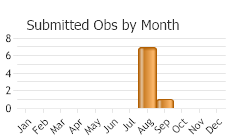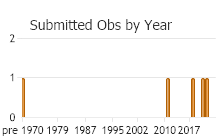View in other NatureServe Network Field Guides
NatureServe
Montana
Utah
Wyoming
Idaho
Wisconsin
British Columbia
South Carolina
Yukon
California
New York
Pictured Grasshopper - Dactylotum bicolor
General Description
A flightless, striking grasshopper, distinctly banded with contrasting reddish-orange, yellow or white, and blue or black body colors, a pattern for which this species is often called the “Barber-pole” or “Painted” Grasshopper (Scott 2010). The following is taken from Capinera et al. (2004), Isley (1938), and Vickery and Kevan (1985). Despite its striking coloration it is often difficult to detect amid its natural background habitat due to its fragmented color pattern. It is among the few “warning” species within the Orthoptera, and known to be distasteful to birds.
Phenology
The Pictured Grasshopper passes the winter underground in the egg stage. The eggs hatch late in early summer. Adults are present in August and September. The species is relatively short-lived (Vickery and Kevan 1985).
Diagnostic Characteristics
The following is taken from Capinera et. al. (2004), Isley (1938), Scott (2010), and Vickery and Kevan (1985). This is a medium size grasshopper. The male body length is about 24 mm and female about 32 mm. The pronotum is somewhat cylindrical and textured with small depressions. The dorsal posterior margin of the pronotum is rounded. The tegmina (forewings) are very small and black with fine yellow veins. There are two subspecies: D. bicolor pictum and D. bicolor varigatum. The Montana subspecies is D. bicolor pictum.
There is never any confusion nor difficulty in identifying this species.
Species Range
Montana Range
Range Descriptions

 Native
Native
Range Comments
Western edge of the Great Plains from southern Alberta, Canada, to northern Mexico; extending into southeastern Arizona (D. bicolor varigatum). Range in Montana is the eastern third of the state with confirmed reports for 7 counties. (Vickery and Kevan 1985, Scott 2010).
Observations in Montana Natural Heritage Program Database
Number of Observations: 13
(Click on the following maps and charts to see full sized version)
Map Help and Descriptions
Relative Density

Recency



 (Observations spanning multiple months or years are excluded from time charts)
(Observations spanning multiple months or years are excluded from time charts)
Habitat
Inhabits short-grass prairie and sagebrush steppe areas of sparse vegetation. Has been found to be sometimes numerous in alfalfa fields, but only for the more southern subspecies, D. bicolor varigatum (Capinera and Sechrist 1982, and Vickery and Kevan 1985).
Food Habits
Feeds on low-growing, broad-leaf plants, such as
scarlet globemallow (
Sphaeralcea coccinea) and scurf-pea,
Psoralidium sp. Species is considered “forbivorus” and of little “economic pest” importance (Capinera and Sechrist 1982, and Vickery and Kevan 1985).
Reproductive Characteristics
The following is taken from Capinera et al. (2004) and Vickery and Kevan (1985). Overwinters in the egg stage. 15 to 25 eggs are deposited within 3 or 4 pods and hatch relatively late in summer. This species seems to prefer creek loam, sand sites and other soft soils for oviposition. Currently, the number of nymphal instars has not been determined.
Stewardship Responsibility
References
- Literature Cited AboveLegend:
 View Online Publication
View Online Publication Capinera, J.L. and T.S. Sechrist. 1982. Grasshoppers of Colorado: Identification, Biology, and Management. Fort Collins, CO: Colorado State University Experiment Station, Bulletin 584S. 161 p.
Capinera, J.L. and T.S. Sechrist. 1982. Grasshoppers of Colorado: Identification, Biology, and Management. Fort Collins, CO: Colorado State University Experiment Station, Bulletin 584S. 161 p. Capinera, J.L., R.D. Scott, and T.J. Walker. 2004. Field Guide to Grasshoppers, Katydids, and Crickets of the United States. Ithaca, NY. Cornell University Press.
Capinera, J.L., R.D. Scott, and T.J. Walker. 2004. Field Guide to Grasshoppers, Katydids, and Crickets of the United States. Ithaca, NY. Cornell University Press. Isley, F.B. 1938. Survival value of acridian protective coloration. Ecology 19(3):370-389.
Isley, F.B. 1938. Survival value of acridian protective coloration. Ecology 19(3):370-389. Scott, R.D. 2010. Montana Grasshoppers, Katydids, and Crickets A Pictorial Field Guide to the Orthoptera. MagpieMTGraphics, Billings, MT.
Scott, R.D. 2010. Montana Grasshoppers, Katydids, and Crickets A Pictorial Field Guide to the Orthoptera. MagpieMTGraphics, Billings, MT. Vickery, V. R. and D. K. M. Kevan. 1985. The grasshopper, crickets, and related insects of Canada and adjacent regions. Biosystematics Research Institute, Ottawa, Ontario. Publication Number 1777. 918 pp.
Vickery, V. R. and D. K. M. Kevan. 1985. The grasshopper, crickets, and related insects of Canada and adjacent regions. Biosystematics Research Institute, Ottawa, Ontario. Publication Number 1777. 918 pp.
- Additional ReferencesLegend:
 View Online Publication
View Online Publication
Do you know of a citation we're missing? Anderson, N.L. 1962. Grasshopper-vegetation relationships on Montana grasslands. Ph.D Dissertation. Bozeman, Montana: Montana State University. 73 p.
Anderson, N.L. 1962. Grasshopper-vegetation relationships on Montana grasslands. Ph.D Dissertation. Bozeman, Montana: Montana State University. 73 p. Hebard, M. 1928. The Orthoptera of Montana. Proceedings of the Academy of Natural Sciences of Philadelphia, Vol. 80:211-306.
Hebard, M. 1928. The Orthoptera of Montana. Proceedings of the Academy of Natural Sciences of Philadelphia, Vol. 80:211-306. Hebard, M. 1932. Notes on Montana Orthoptera. Proceedings of the Academy of Natural Sciences of Philadelphia. V. 84. pp 251-257.
Hebard, M. 1932. Notes on Montana Orthoptera. Proceedings of the Academy of Natural Sciences of Philadelphia. V. 84. pp 251-257.
- Web Search Engines for Articles on "Pictured Grasshopper"
- Additional Sources of Information Related to "Insects"





